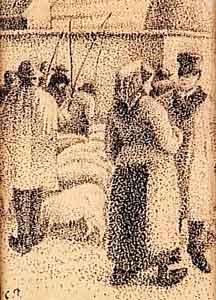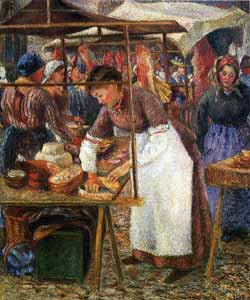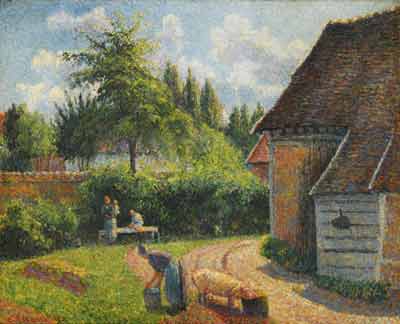France, (1830-1903)

-
The Pork Butcher
- (1883), oil on canvas
- 25.6 x 21.4 in. (65.1 x 54.3 cm.)
- Tate Gallery
-
Editor’s Note:
The market portrayed in both the above works is the weekly market held in the town of Pontoise, located in the northwestern suburbs of Paris. Camille Pissarro lived in Pontoise for seventeen years. A short train ride from the center of Paris, Pontoise became one of the capitals of the impressionist movement.
Many painters, including van Gogh, Cézanne, Daubigny and Caillebotte, took this city and surrounding area as a starting point for the creation of landscapes. In the early 1880s Pissarro painted a number of market scenes characterized by close-up views of people, especially women, engaged in their daily activities.
About the Artist
Camille Pissarro, (1830-1903), was a French Impressionist painter. Born in St. Thomas in the Dutch West Indies to French parents, by 1855 he was studying art in Paris and met Monet, Guillaumin, and Cezanne. By 1866 he was painting entirely outdoors and living in dire poverty and would endured prolonged financial hardship much of his life in keeping faith with the aims of Impressionism.
Pissarro’s development was guided by the way scenes and objects imprinted on his mind. He recorded aspect of the subject in faithful detail, especially conditions of light because he perceived light as inseparable from the things it illuminated. Painting out-of-doors, he developed a personal style much influenced by Courbet and Corot but with a distinct feeling for structure and contrasting tonal values in the landscape. Pissarro had his first painting accepted at the Salon of 1859, then joined with Cezanne, Manet, and others in the 1863 Salon des Refuses. and participated in all seven subsequent group shows.
His work gave way in the mid-eighties to a divisionist manner inspired by Seurat, but he returned to a looser, less “scientific” style in the early nineties, and his late serial paintings of cityscapes and harbors are among his greatest achievements. Despite acute eye trouble, his later years were his most prolific. [DES-02/16]



